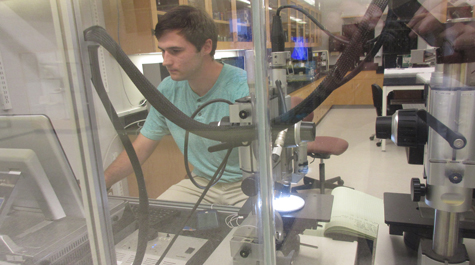W&M joins other Virginia research universities in instrument-sharing agreement
William & Mary has joined six other Virginia research institutions in a formal agreement that will encourage shared use of scientific instrumentation.
The other signatories of the five-year Memorandum of Understanding are Virginia Commonwealth University, George Mason University, University of Virginia, Eastern Virginia Medical School, Old Dominion University and Virginia Tech.
“William & Mary hopes and expects this agreement to share resources will heighten the efficiency of each participant’s efforts and the excellence of research done in the commonwealth,” said William & Mary President Taylor Reveley. “Effective collaboration can bear rich fruit for us all.”
The MOU formalizes and places on an institutional basis the casual scientist-helping-scientist practices of the past, explained Dennis Manos, William & Mary’s vice provost for research. He credits CEO Michael Grisham of the Virginia Biosciences Health Research Corporation (VBHRC) with spearheading the drive that led to the agreement, which was based on an existing mutual-assistance arrangement between the University of Virginia and Virginia Commonwealth University.
The instrument-sharing agreement is the second multi-university collaborative program orchestrated by VBHRC. The Virginia Neuroscience Initiative (VNI) is a collaborative that involves all the signatories of the instrument-sharing MOU plus five medical centers.
Manos explained that VNI’s goal is to facilitate collaboration among researchers and includes a registry of Virginia neuroscientists. While the new collaborative is based on instruments, rather than individuals, organized sharing of important lab equipment across the commonwealth is a practice that will benefit all participants, he added.
“One part of the idea is that we can increase the effectiveness of the faculty, staff and students doing research work in the universities,” Manos said. “Every institution can’t own every scientific instrument, and pooling resources is one way of making sure that we’re not limited by the in-house existence or availability of a piece of equipment to do a job.”
Manos said the agreement will create a pool of laboratory instruments for the common use of Virginia’s scientists. A researcher will be able to use equipment at another consortium university at the same cost as scientists at the host institution.
“For instance, we have a transmission electron microscope that’s good enough for most of what we do, but UVA has a better TEM. It’s unbelievably good,” he said. “In the event that one of our folks finds our instrument inadequate for their work, it would be nice to use the better one that our colleagues have in Charlottesville.”
An online inventory of the instrumentation at all seven institutions is being prepared, so that scientists with a question will know what institution can offer equipment that can point to an answer. Manos noted that William & Mary will be adding a long slate of instruments to the list, including the university’s 17.5-tesla NMR magnet, a live-cell confocal microscope and $1.5 million in equipment recently added to the Integrated Science Center through the Cabell Challenge.
It’s unrealistic to think that all of the spectrometers, CAT scanners, confocal microscopes and other machines that make up Virginia’s STEM arsenal are sitting idle and ready for use by a guest, and so Manos said that an ideal inventory will include updated information on availability of each instrument, in addition to a description of the capabilities.
“On any given day, you don’t know what piece of equipment is working and you don't know what is available,” he said, adding that sometimes an instrument is dedicated for a single experiment for months, even years. “That’s part of the beauty of having a centralized inventory.“
Each member of the consortium will appoint faculty who will act as contacts for intermural instrument use. Christopher Del Negro, chair of the Department of Applied Science, and Eric Bradley, chair of the Department of Biology, are points of contact at William & Mary.
A list of available instruments throughout Virginia is only a start, as Manos points out that sharing the necessary know-how for operating equipment and interpreting the results is implicit in the agreement. He used the example of William & Mary’s time of flight secondary ion mass spectrometer (TOF-SIMS), an expensive and versatile device that is useful for understanding the detailed surface characteristics of a wide range of materials, ranging from organic tissue to semiconductors.
“We have experts who have been using the TOF-SIMS for years, and we’re good at interpreting what the data means. If someone came from another university to use our TOF-SIMS and we’re puzzled by their data, we would happily talk with them,” he said.
VBHRC, also known as the Virginia Catalyst, is a not-for-profit 501(c)(3) corporation funded by the Virginia General Assembly’s general fund and seven of Virginia’s research universities, including William & Mary. A press release announcing the signing of the MOU reports that the organization has now awarded 24 grants totaling $10 million, combined with $20 million in matching funds, which financed the achievement of meaningful milestones. This support resulted in follow-on funding of an additional $80 million and the creation of high-paying jobs throughout the Commonwealth, the release noted.














